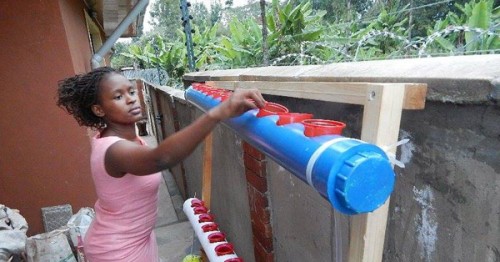They also offer protection against the elements. The presence of a vertical garden can shield your home’s exterior against bad weather or the harsh rays of the sun, which tend to crack and peel off wall paint. Placing a vertical garden against the wall will save you money on repainting your home.
From a decor perspective, an attractive arrangement of flowers and plants can be used to conceal unsightly items like trash cans, electric meters and exposed pipes. In such instances, a vertical garden built using a freestanding frame can be used as a screen to cover up any unpleasantness.
This post contains Amazon affiliate links, meaning I may earn a small commission if you purchase through my links, at no extra cost to you. Note: We aim to provide accurate product links, but some may occasionally expire or become unavailable. If this happens, please search directly on Amazon for the product or a suitable alternative.

Another aspect that makes vertical gardening favorable with homeowners is that it encourages people to use re-purposed materials. Property owners can use anything from plastic bottles to discarded shutters, crates, and old pipes.
These are just some of the benefits that come with installing a vertical garden on your property:
Increased Growing Area
For the same floor area, Vertical Farm Systems multi-level design provides nearly 8 times more growing area than single level greenhouse or traditional farming systems. This compact design enables cost-effective farming installations in industrial estates, urban areas and other low cost and typically under-utilized environments not previously associated with high-quality high-margin agricultural activities.
Maximum Crop Yield
Irrespective of external conditions, Vertical Farm Systems can reliably provide more crop rotations per year than open field agriculture and other farming practices. Crop cycles are also faster due to the systems’ controlled temperature, humidity, daylight hours optimization and and use of grow lights thereby extending daily plant growth duration. The systems can produce market grade produce of several crops within just 45 days.
Low Labor Costs
Vertical Farm Systems can be automated growing systems with automatic SMS text messaging. Manual labor is only required on-site for planting, harvesting and packaging of crops – and the required skill levels are very low.
Low Water Usage (water conservation)
Being a totally closed growing system with controlled transpiration losses, Vertical Farm Systems use only around 10% of the water required for traditional open field farming and around 20% less than conventional hydroponics.Water is directly channeled to the plant roots where it is needed for growth.
Reduced Transport Costs
Vertical Farm Systems can be established in any geographic location with suitable power and water supplies including urban areas e.g. Balconies, car-park, roof top e.t.c. Strategic positioning of facilities close to the point of consumption/sale or in distribution hubs dramatically decreases the time from harvest to consumer and also reduces costs for refrigerated storage and transport. The system increases fresh and healthy supplies to the consumer market.
Learn more at: Vertical Farming






